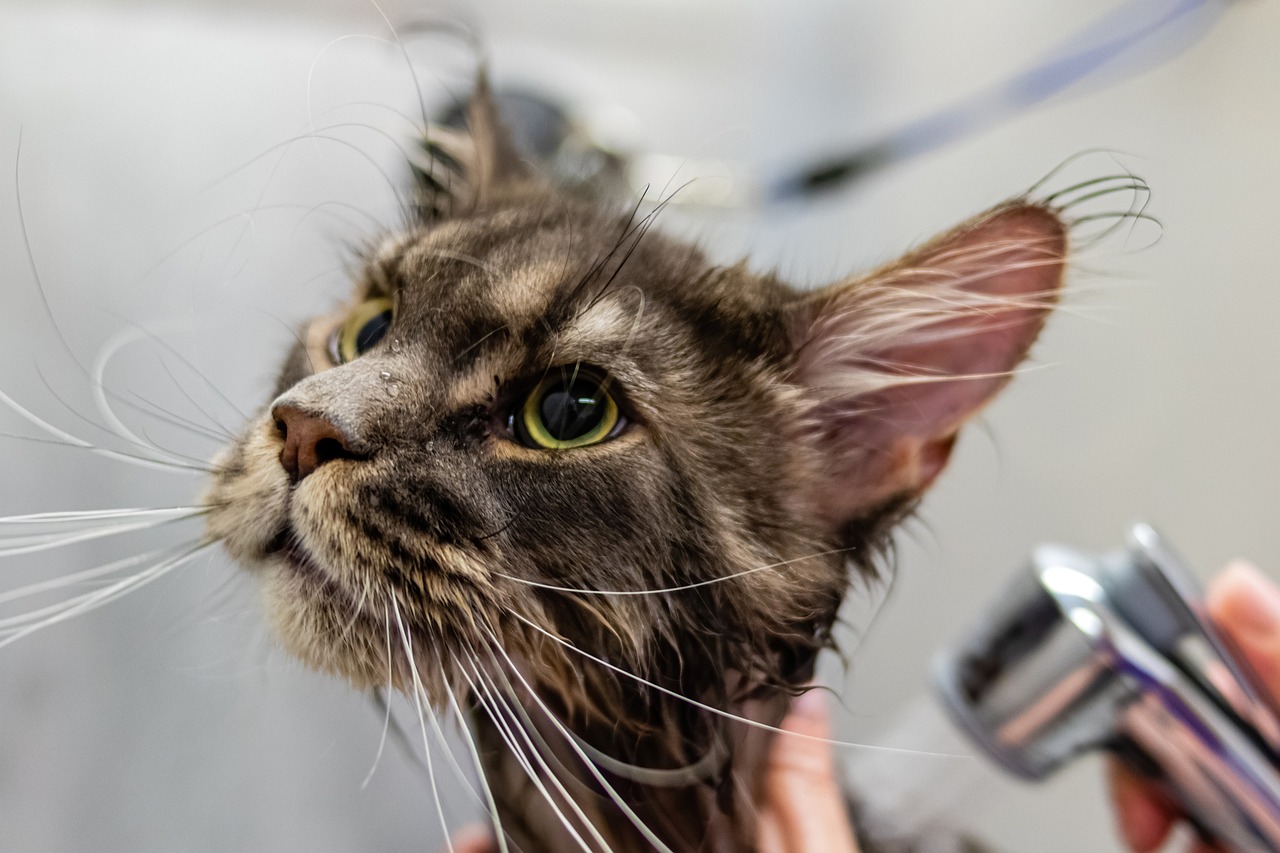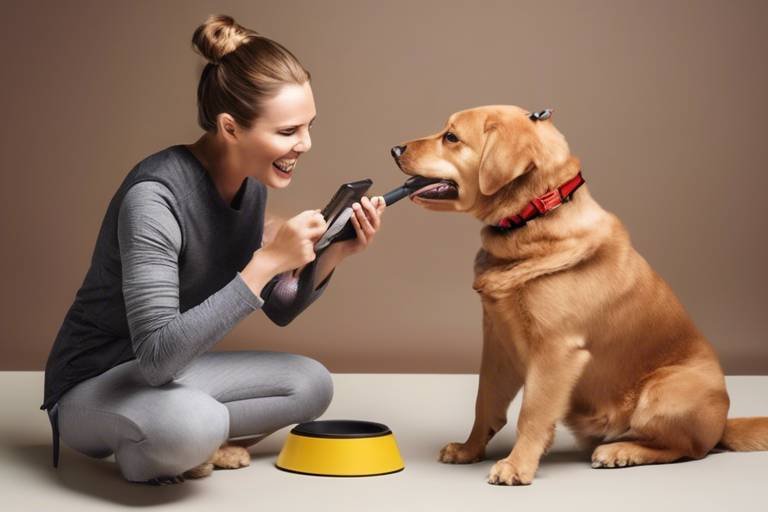How to Help Your Pet Cope With Change
Life is full of changes, and while we humans tend to adapt, our furry friends may struggle to keep up. Whether it's moving to a new home, welcoming a new family member, or even a change in routine, pets can experience a whirlwind of emotions. Just like us, they can feel a mix of excitement, anxiety, and confusion. So, how can we help them navigate these changes smoothly? In this article, we’ll explore effective strategies that can make a world of difference for your pet, ensuring their comfort and well-being during these transitions.
Recognizing the signs of anxiety in pets is crucial. Have you ever noticed your pet acting unusually? Maybe they’re hiding, barking excessively, or even refusing to eat. These behaviors can be red flags indicating that your pet is stressed. Common signs of anxiety include:
- Excessive barking or meowing
- Destructive behavior, like chewing furniture
- Hiding or avoiding interaction
- Changes in appetite or sleep patterns
Identifying these signs early can help you take proactive steps to support your pet. Remember, pets can’t verbally express their feelings, but they communicate through their behavior. Being attentive to these cues can foster a stronger bond between you and your pet.
Establishing a secure environment can significantly ease your pet's anxiety. Think of it as their personal sanctuary, a place where they can retreat when the world feels overwhelming. To create this comforting space, consider the following:
The location of your pet's safe space plays a vital role in their comfort. Ideally, it should be a quiet area away from the hustle and bustle of daily life. Look for spots that are cozy and familiar to your pet, such as:
- A corner of the living room with their favorite blanket
- A quiet bedroom where they can relax undisturbed
- A designated crate or bed that feels safe
By selecting the right location, you can create an oasis of calm that helps your pet feel secure during times of change.
In this section, we highlight essential items that can enhance your pet’s safe space. Think of these items as the building blocks of comfort. Some must-haves include:
- Blankets: Soft, familiar blankets can provide warmth and a sense of security.
- Toys: Having their favorite toys nearby can offer a comforting distraction.
- Calming Aids: Consider using pheromone diffusers or calming sprays designed for pets.
These items can transform a simple space into a haven, allowing your pet to feel more at ease during stressful times.
Introducing changes slowly can help your pet adjust better. Think of it like easing into a swimming pool; jumping in all at once can be shocking! Instead, you want to acclimate them gradually. For instance, if you're moving, allow your pet to explore the new space before the big day. Let them sniff around and get familiar with their new surroundings. This gradual exposure can make a significant difference in how they cope.
Positive reinforcement is a powerful tool for encouraging desired behaviors. It’s all about rewarding your pet when they handle a change well. For example, if they explore their new home without showing signs of stress, shower them with praise or a treat. This reinforces the idea that change can be a good thing and encourages them to approach new situations with confidence.
Tracking your pet's adjustment is important. Keep an eye on their behavior and emotional state throughout the process. Are they becoming more comfortable? Are there still signs of anxiety? Regularly check in on their progress, and don't hesitate to adjust your approach if necessary. Just like humans, pets thrive on routine and reassurance, so being attentive can lead to a smoother transition.
Sometimes, pets may need additional support. If your efforts don’t seem to be helping, it might be time to seek professional help. This could involve consulting with a veterinarian or a professional trainer who specializes in pet anxiety. They can provide tailored strategies and, if necessary, recommend behavioral therapies or medications to help your pet cope.
Consistency is key in helping pets cope. Maintaining familiar routines during times of change can provide a sense of stability. For example, try to keep feeding times, walks, and play sessions as regular as possible. This predictability can help alleviate anxiety, as your pet will know what to expect, even when everything else feels uncertain.
Regular physical activity is essential for your pet's well-being. Incorporating exercise into their daily routine can help relieve stress and promote a sense of normalcy. Whether it’s a long walk, a game of fetch, or some interactive playtime, keeping your pet active can work wonders for their mood.
Maintaining consistent feeding and care schedules can provide stability. Stick to their regular diet and grooming routine as much as possible. This consistency can help your pet feel more secure, knowing that some things remain unchanged even during turbulent times.
Q: How long does it take for a pet to adjust to change?
A: Adjustment periods vary by pet. Some may adapt within days, while others may take weeks. Patience and understanding are key.
Q: What should I do if my pet shows severe anxiety?
A: If your pet exhibits severe anxiety, consult a veterinarian or a professional trainer for advice tailored to your situation.
Q: Are there specific calming products you recommend?
A: Many pet owners find success with pheromone diffusers, calming collars, and anxiety wraps. Always consult your vet before trying new products.

Understanding Pet Anxiety
This article explores effective strategies to assist your pet in adjusting to various life changes, ensuring their comfort and well-being during transitions.
Recognizing the signs of anxiety in pets is crucial for their well-being. Just like us, pets can experience stress and anxiety due to various changes in their environment or routine. Have you ever noticed your furry friend acting a bit off? Maybe they're hiding under the bed or barking excessively? These behaviors could be their way of expressing discomfort. Common signs of anxiety in pets include:
- Excessive barking or meowing: This can be a signal that your pet is feeling anxious or threatened.
- Destructive behavior: Chewing on furniture or digging can indicate stress levels that need addressing.
- Avoidance: If your pet is seeking solitude or hiding, it may be a sign of anxiety.
- Changes in eating habits: A sudden loss of appetite or overeating can reflect emotional distress.
Understanding these signs is the first step in helping your pet cope. It’s like being a detective, observing their behavior and piecing together the puzzle of their emotional state. You might be surprised to learn that pets can be just as sensitive to changes in their lives as we are. For instance, moving to a new home, welcoming a new family member, or even changes in your own routine can all trigger anxiety in pets.
So, how can you identify these signs early? The key is to pay attention to your pet's normal behavior. If your usually playful pup suddenly becomes withdrawn, or your curious cat starts avoiding interaction, it’s time to take a closer look. Keeping a journal of their behavior can also help you spot patterns and changes over time.
In some cases, anxiety might manifest physically. Pets can exhibit symptoms like trembling, excessive grooming, or even gastrointestinal issues. If you notice these physical signs alongside behavioral changes, it’s essential to consult with a veterinarian. They can help rule out any underlying health issues and provide guidance on how to best support your pet through their anxiety.
Ultimately, understanding pet anxiety is about being attuned to your furry friend’s needs. By recognizing the signs and being proactive, you can create an environment that fosters comfort and security. Remember, your pet relies on you to be their advocate, so tuning in to their emotional state is crucial for their happiness.
Establishing a secure environment can significantly ease your pet's anxiety. Here, we discuss how to create a comforting space tailored to your pet’s needs.
The location of your pet's safe space plays a vital role in their comfort. We’ll explore ideal spots that promote relaxation and security.
In this section, we highlight essential items that can enhance your pet’s safe space, such as blankets, toys, and calming aids.
Introducing changes slowly can help your pet adjust better. This part covers techniques for gradual exposure to new environments or routines.
Positive reinforcement is a powerful tool for encouraging desired behaviors. We’ll discuss how to implement this effectively during transitions.
Tracking your pet's adjustment is important. This section provides tips on how to monitor their behavior and emotional state throughout the process.
Sometimes, pets may need additional support. Here, we discuss when and how to seek professional help, including trainers and veterinarians.
Consistency is key in helping pets cope. This section emphasizes the importance of maintaining familiar routines during times of change.
Regular physical activity is essential for your pet's well-being. We’ll cover how to incorporate exercise into their daily routine to alleviate stress.
Maintaining consistent feeding and care schedules can provide stability. Here, we discuss strategies to keep these aspects regular during transitions.
Q: How can I tell if my pet is anxious?
A: Look for signs like excessive barking, destructive behavior, or changes in eating habits.
Q: What should I do if my pet shows signs of anxiety?
A: Create a safe space, maintain routines, and consult a veterinarian if necessary.
Q: Can I help my pet cope with anxiety on my own?
A: Yes, implementing gradual changes, positive reinforcement, and monitoring their behavior can be very effective.

Creating a Safe Space
Creating a safe space for your pet is one of the most effective strategies to help them cope with change. Just like we all need a cozy corner to retreat to when life gets overwhelming, our furry friends also thrive in environments that make them feel secure and at ease. Imagine a place where your pet can curl up, feel protected, and escape the stresses of the world around them. This sanctuary can be a game-changer during times of transition, whether it's moving to a new home, welcoming a new family member, or dealing with changes in routine.
To start, consider the layout of your home. The location of your pet's safe space plays a vital role in their comfort. Ideally, this area should be away from the hustle and bustle of daily activities—think of it as their personal retreat. A quiet corner of the living room, a cozy spot in the bedroom, or even a designated area in a basement can work wonders. Ensure it's a space that feels safe and familiar, away from loud noises and foot traffic. If your pet has a favorite blanket or bed, make sure to include that in their safe zone. It’s all about creating a bubble of tranquility in a chaotic world.
When selecting the perfect spot for your pet's safe space, consider these factors:
- Noise Level: Choose a location that minimizes exposure to loud sounds, such as traffic or household appliances.
- Accessibility: Ensure your pet can easily access their safe space whenever they need it.
- Familiarity: If possible, set up their safe area in a place they already know and feel comfortable in.
Now that you have the location sorted, let’s talk about essential comfort items that can enhance this space. Think of these items as the building blocks of your pet’s sanctuary. A plush bed can provide the ultimate comfort, while their favorite toys can offer a sense of familiarity and joy. Calming aids, such as pheromone diffusers or soft music, can also help soothe anxious pets. Incorporating these elements not only makes the space inviting but also promotes relaxation and emotional stability.
Here are some must-have items to consider for your pet's safe space:
- Cozy Bedding: A soft, warm bed or blanket where they can snuggle up and feel secure.
- Toys: Familiar toys that they love can create a sense of joy and comfort.
- Calming Aids: Products like calming sprays, pheromone diffusers, or even a soft, soothing blanket can help ease anxiety.
Incorporating these elements into your pet's safe space will not only help them feel more secure but also give them the tools they need to cope with any changes in their environment. Remember, the goal is to create a haven where your pet can retreat and recharge. By taking the time to set up this special area, you're not just helping them cope with change—you're showing them that they are loved and cared for. And that, in itself, is a powerful antidote to anxiety.
Q: How can I tell if my pet is feeling anxious?
A: Look for signs such as excessive barking, hiding, destructive behavior, or changes in eating habits. If your pet seems restless or is pacing, they may be experiencing anxiety.
Q: Can I create a safe space for multiple pets?
A: Yes! Just ensure that each pet has their own designated area to retreat to. This helps prevent any territorial disputes and allows each pet to feel secure.
Q: How long should my pet stay in their safe space during a transition?
A: Allow your pet to spend as much time as they need in their safe space. It's important to let them come out when they feel comfortable, so avoid forcing them out.
Choosing the Right Location
When it comes to helping your pet cope with change, one of the most vital steps is selecting the right location for their safe space. This area should be a haven where they can retreat to feel secure and relaxed. Think of it as their personal sanctuary—a cozy nook that shields them from the chaos of the outside world. But how do you choose the perfect spot? Well, there are a few key factors to consider.
First and foremost, think about the noise levels in your home. If you live in a bustling household or have frequent visitors, a quieter corner away from the main activity can be ideal. Look for spots that are away from loud appliances, high-traffic areas, or even windows that face busy streets. A serene environment can drastically reduce anxiety and allow your pet to unwind.
Next, consider the temperature of the location. Pets, like us, can be sensitive to extreme temperatures. A location that is too hot or too cold can add to their discomfort. Ideally, choose a space that maintains a comfortable temperature year-round. For instance, a cozy corner in your living room might be great during the winter, but a shaded area in the summer might be more suitable.
Additionally, think about the proximity to family members. Pets often feel more secure when they can see or hear their humans. Placing their safe space in a location where they can still feel connected to the family can help ease their anxiety. However, balance this with the need for quiet; sometimes, a little distance from the hustle and bustle is necessary for them to relax.
Another important aspect is accessibility. Your pet should be able to reach their safe space easily, especially during stressful times. If they have mobility issues, ensure that the area is free from obstacles and easy to navigate. A space that is easy to access will encourage them to use it whenever they feel overwhelmed.
Lastly, don't forget to personalize the space. Adding familiar items, such as their favorite blanket or bed, can make a world of difference. You can even include some of their beloved toys or a piece of your clothing to provide a sense of comfort and familiarity. Just like a child might cling to a favorite stuffed animal, your pet will find solace in their cherished belongings.
In summary, choosing the right location for your pet’s safe space involves considering noise levels, temperature, proximity to family, accessibility, and personalization. By thoughtfully selecting an area that meets these criteria, you can create a comforting environment that helps your pet navigate through life’s changes with greater ease.
- What signs indicate my pet needs a safe space? Look for signs of anxiety such as excessive barking, hiding, or destructive behavior.
- How can I tell if my pet is comfortable in their safe space? If they frequently use the space and seem relaxed, they likely feel secure there.
- Can I change the location of their safe space? Yes, but do it gradually to allow your pet to adjust to the new environment.
Essential Comfort Items
When it comes to helping your furry friend feel secure during times of change, the right comfort items can make all the difference. Just like humans, pets thrive in environments where they feel safe and cozy. Think of these items as their personal "security blanket"—a way to provide reassurance when everything else around them seems uncertain. So, what are these essential comfort items that can help your pet feel at ease?
First on the list is a comfortable bed. A soft, supportive bed can provide your pet with a designated space to retreat to when they need a break from the chaos. Look for beds that are not only plush but also appropriately sized for your pet. A snug fit can enhance their feelings of security. You might even consider a bed with raised edges, as it can resemble a den-like environment, which many pets find soothing.
Next, consider adding some calming blankets. These can be particularly effective for pets that enjoy burrowing or snuggling. A blanket infused with calming scents, like lavender, can help create a tranquil atmosphere. You can also place a familiar blanket in their safe space to provide a sense of continuity and comfort. This familiar smell can act as a reminder of home, which is especially important during transitions.
Don't forget about toys. Engaging toys can keep your pet distracted and entertained, reducing feelings of anxiety. Opt for toys that stimulate their senses, such as those that squeak or have varying textures. Additionally, consider interactive toys that challenge their minds, as keeping their brains busy can help alleviate stress. Just like a child finds comfort in their favorite stuffed animal, your pet will appreciate having something to cuddle or play with during tough times.
Another essential item to consider is a calming aid. Products like pheromone diffusers or calming collars can help create a peaceful environment. These aids mimic the natural pheromones that mother animals produce to comfort their young, providing a sense of calm and security. However, always consult with your veterinarian before introducing any new products to ensure they are safe and suitable for your pet.
Finally, a safe space is incomplete without the right environmental setup. This includes ensuring that the area is quiet, away from loud noises or sudden disruptions. You might want to use curtains to block out any outside distractions or create a cozy nook with soft lighting. Remember, the goal is to create an oasis where your pet can relax and feel at home, no matter what changes are happening around them.
In summary, the right comfort items can significantly enhance your pet's ability to cope with change. By providing a mix of physical comfort, mental stimulation, and a calming atmosphere, you can help your beloved companion navigate through transitions more smoothly. Always observe your pet's reactions to these items and make adjustments as necessary to ensure their comfort and happiness.
- What are the signs that my pet is anxious?
Common signs include excessive barking, hiding, destructive behavior, and changes in eating habits. - How can I tell if my pet is comfortable in their safe space?
If your pet frequently retreats to their designated area, relaxes, and shows signs of contentment, they likely feel comfortable. - Can I use human calming items for my pet?
It's best to avoid human products unless specifically recommended by a veterinarian, as some may not be safe for pets. - How long does it take for a pet to adjust to changes?
Adjustment times vary widely depending on the pet and the nature of the change, but patience and consistency are key.

Gradual Introductions to Change
Change can be a daunting experience for our furry friends, just as it can be for us. When faced with new environments, different routines, or even the arrival of new family members, pets often feel a wave of uncertainty. This is where the concept of gradual introductions comes into play. Instead of throwing your pet into the deep end, a slow and steady approach can help them feel more at ease. Think of it like introducing a friend to a new group; a gentle introduction can make all the difference in how comfortable they feel.
Start by allowing your pet to explore new changes at their own pace. For example, if you’re moving to a new home, let them sniff around the boxes before the big move. This not only familiarizes them with the new scents but also helps them associate the change with a sense of adventure rather than fear. You can create a step-by-step plan to introduce changes, ensuring that your pet feels secure throughout the process.
Here’s a simple framework for gradual introductions:
| Step | Action | Purpose |
|---|---|---|
| 1 | Familiarize with the new environment | Allow your pet to explore the area without pressure. |
| 2 | Short visits | Spend brief periods in the new space, gradually increasing the time. |
| 3 | Introduce new routines | Gradually adjust feeding and walking times to match the new schedule. |
| 4 | Positive associations | Use treats and praise to create a positive link with the changes. |
During this process, it’s essential to monitor your pet’s reactions. If they seem anxious or fearful, take a step back. Every pet is unique, and some may need more time than others. You might notice them displaying signs of stress, such as excessive barking, hiding, or even changes in appetite. If this happens, don’t hesitate to revert to a previous step until they feel more comfortable.
Using positive reinforcement is another effective strategy during these transitions. When your pet exhibits calm behavior in the face of change, reward them with treats, affection, or playtime. This not only boosts their confidence but also reinforces the idea that new experiences can be positive. Remember, you’re not just helping them adapt; you’re also building their resilience for future changes.
In conclusion, gradual introductions to change can significantly ease your pet’s anxiety and help them adjust more smoothly. By taking the time to understand their needs and providing a supportive environment, you can turn potentially stressful situations into opportunities for bonding and growth. So, the next time you’re faced with a change, remember: slow and steady wins the race!
Q: How long should I take to introduce my pet to a new environment?
A: It varies depending on the pet and the situation. Some may adjust in a few days, while others might need weeks. Pay attention to your pet's cues.
Q: What if my pet shows signs of extreme anxiety?
A: If your pet is excessively anxious, consider consulting a veterinarian or a pet behaviorist for tailored advice and possible interventions.
Q: Can I use calming products during the transition?
A: Yes, products such as calming collars, pheromone diffusers, or anxiety wraps can help ease your pet's stress during transitions.
Using Positive Reinforcement
When it comes to helping your pet adjust to change, positive reinforcement is a game changer. Think of it as a motivational boost for your furry friend! Just like how we feel encouraged when someone praises us, pets thrive on recognition and rewards. By acknowledging their good behavior, you’re not just helping them feel better; you’re also building a stronger bond between the two of you.
So, how does positive reinforcement work? It’s simple! Whenever your pet exhibits calm behavior or successfully navigates a new situation, reward them with treats, affection, or even their favorite toy. This method creates a positive association with the change, making it less intimidating. For instance, if you’re introducing your pet to a new environment, give them a treat when they explore confidently. This encourages them to embrace the change rather than shy away from it.
Consistency is key! Make sure to reward your pet immediately after they display the desired behavior. This helps them connect the dots between their actions and the rewards. You might be wondering, “How can I keep track of what works?” A simple chart can help you monitor your pet’s progress. Here’s a quick example:
| Date | Behavior Observed | Reward Given | Notes |
|---|---|---|---|
| 01/10/2023 | Explored new room | Favorite treat | Seemed curious and relaxed |
| 01/11/2023 | Played with new toy | Extra playtime | Engaged and happy |
Additionally, remember that every pet is unique. What works for one may not work for another. For example, some pets may respond better to verbal praise than treats. Experiment with different types of rewards to find what resonates best with your furry companion. You’ll be surprised at how quickly they catch on!
Lastly, patience is essential. Change can be overwhelming, and your pet may not respond immediately. Celebrate small victories and keep reinforcing positive behavior. Over time, your pet will learn to navigate changes with confidence and ease, all thanks to your encouragement and support.
- What is positive reinforcement? Positive reinforcement is a training method that rewards desired behaviors to encourage them in the future.
- How do I know what rewards to use? Observe your pet's preferences. Treats, toys, and praise can all be effective rewards.
- Can positive reinforcement work for all pets? Yes, but each pet is different. Tailor your approach to their unique personality and preferences.
- How long should I use positive reinforcement? Continue using it as long as necessary, especially during transitions. It's a great way to build trust and confidence.
Monitoring Progress
Monitoring your pet's progress during times of change is essential for ensuring their emotional well-being. Just like humans, pets can experience a range of feelings when faced with new environments or routines. Being attentive to their behavior can provide valuable insights into how well they are coping. So, how do you keep track of your furry friend's emotional state? It’s all about observation and documentation.
First, consider keeping a pet journal. This can be as simple as a notebook or a digital document where you jot down your pet's daily behaviors, moods, and any changes you notice. For example, if your dog usually greets you at the door with a wagging tail but has started to hide under the couch, that’s a sign worth noting. Regular entries can help you identify patterns over time. Here’s what you might want to include in your journal:
| Date | Behavior Observed | Notes |
|---|---|---|
| October 1 | Hiding during thunderstorms | Used calming blanket, seemed to help |
| October 3 | Refusing to eat | Changed feeding location; eating resumed |
Additionally, you can set specific milestones for your pet's adjustment. For instance, if you’ve recently moved to a new home, you might aim for your pet to feel comfortable in their new surroundings within a month. Break this down into smaller goals, such as:
- Week 1: Explore the new space together.
- Week 2: Introduce familiar items like toys and blankets.
- Week 3: Gradually increase time spent in different areas of the home.
By tracking these milestones, you can celebrate small victories, which can be incredibly uplifting for both you and your pet. Remember, progress may not always be linear. Some days will be better than others, and that's completely normal. The key is to remain patient and observant. If you notice persistent signs of anxiety, such as excessive barking, destructive behavior, or withdrawal, it might be a signal to adjust your approach or seek additional help.
In summary, monitoring your pet's progress is a blend of observation, documentation, and celebration of their achievements. By staying engaged and responsive to their needs, you can help them navigate through change with greater ease and confidence.
Q1: How can I tell if my pet is anxious?
A1: Look for signs such as excessive barking, hiding, changes in appetite, or destructive behavior. These can indicate that your pet is feeling stressed or anxious.
Q2: What should I do if my pet shows signs of anxiety?
A2: Create a safe space for your pet, maintain routines, and consider using calming aids. If anxiety persists, consult a veterinarian or a professional trainer for tailored advice.
Q3: How long does it take for a pet to adjust to change?
A3: Adjustment times vary depending on the pet and the change. Some may adapt quickly, while others might take weeks or even months. Patience and monitoring are key.
Q4: Can I use positive reinforcement to help my pet adjust?
A4: Absolutely! Positive reinforcement can encourage desired behaviors and help your pet feel more secure during transitions. Rewarding them for calm behavior can be particularly effective.

Seeking Professional Help
As much as we love our furry companions, there are times when their anxiety may surpass what we can manage on our own. It's important to recognize that seeking professional help is not a sign of failure, but rather a proactive step towards ensuring your pet's well-being. Just like humans, pets can experience overwhelming stress that may require specialized support. So, how do you know when it's time to reach out for help?
First, consider the severity of your pet's anxiety. If you notice persistent behaviors such as excessive barking, destructive chewing, or hiding, it might be time to consult with a veterinarian or a certified animal behaviorist. These professionals can provide insights tailored to your pet's specific needs and help you develop a comprehensive plan to manage their anxiety. Additionally, they can rule out any underlying health issues that could be contributing to your pet's distress.
When seeking professional help, it's essential to approach the situation with an open mind. Different pets respond to various methods, and what works for one may not work for another. Here are some options to consider:
- Veterinarian Consultation: Your first point of contact should be your veterinarian. They can assess your pet's health and suggest behavioral therapies or medication if necessary.
- Animal Behaviorists: These specialists focus on understanding animal behavior and can provide tailored training programs to help your pet cope with anxiety.
- Dog Trainers: A professional dog trainer can assist with behavioral issues through structured training sessions, reinforcing positive behaviors and reducing anxiety triggers.
Before your appointment, make sure to keep a journal of your pet's behaviors. Note when the anxiety occurs, what triggers it, and how your pet responds. This information can be invaluable for the professionals you consult. They will appreciate the detailed insight and can tailor their recommendations accordingly.
Finally, remember that change takes time. Just as we need time to adapt to new situations, so do our pets. With the right support and a little patience, your pet can learn to navigate their anxiety and find comfort in their new normal. Seeking professional help can be a game-changer, providing you with the tools and knowledge to help your pet thrive.
Q: How do I know if my pet needs professional help?
A: If your pet exhibits severe anxiety symptoms such as constant barking, destructive behavior, or withdrawal, it's a good idea to consult a professional.
Q: What types of professionals can help with pet anxiety?
A: You can seek help from veterinarians, animal behaviorists, or certified dog trainers, depending on your pet's needs.
Q: Is medication necessary for treating pet anxiety?
A: Medication can be an option for some pets, but it's important to discuss this with your veterinarian to determine the best course of action.
Q: How long does it take for a pet to adjust to professional help?
A: Every pet is different, and the adjustment period can vary. Consistent training and support can lead to improvements over time.

Maintaining Routine Amidst Change
When life throws changes our way, whether it's moving to a new home, welcoming a new family member, or even experiencing a shift in your schedule, it can be a whirlwind for both you and your furry friend. Just like us, pets thrive on routine. Maintaining their daily habits can help them feel more secure and less anxious during these transitions. Think of it as a comforting anchor in a sea of uncertainty. So, how can you keep things steady for your pet when everything else feels like it’s spinning out of control?
First and foremost, it's essential to stick to your pet's usual schedule as much as possible. This means keeping their feeding times, walk schedules, and play sessions consistent. Imagine how you would feel if your daily routine suddenly changed; you'd likely feel a bit lost, right? Pets are no different. By adhering to their familiar rhythms, you provide them with a sense of normality. For instance, if your dog is used to a morning walk at 8 AM, try to maintain that time even if your day is hectic.
Another key aspect of maintaining routine is ensuring that your pet's environment remains stable. If you’re moving to a new place, try to set up their space as similarly as possible to their old one. This could involve placing their bed in a quiet corner, keeping their favorite toys accessible, and even using the same type of bedding. The more you can replicate their previous environment, the easier it will be for them to adjust. Remember, pets are creatures of habit, and familiar smells and sights can be incredibly comforting.
To help you visualize how to maintain routines, here’s a simple example of a daily schedule for your pet during a transition:
| Time | Activity |
|---|---|
| 7:00 AM | Feeding |
| 8:00 AM | Morning Walk |
| 10:00 AM | Playtime |
| 12:00 PM | Afternoon Nap |
| 5:00 PM | Evening Walk |
| 6:00 PM | Dinner |
| 8:00 PM | Quiet Time/Training |
In addition to keeping a consistent schedule, engaging in daily exercise and playtime is crucial. Regular physical activity not only helps alleviate stress but also strengthens your bond with your pet. Whether it’s a game of fetch in the backyard or a leisurely stroll around the block, incorporating these activities into your routine allows your pet to expend energy and remain calm. Think of it as a way to channel their excitement and anxiety into something productive.
Lastly, don’t forget about the little things that contribute to their overall well-being. Consistent grooming and care routines can also provide a sense of normalcy. Brush your pet regularly and maintain their hygiene routines as best as you can. These actions can be soothing and reinforce the idea that even amidst change, some things remain constant. Just like how we find comfort in our favorite hobbies or routines, pets do too!
In conclusion, maintaining a routine amidst change is not just beneficial; it’s essential for your pet's emotional health. By keeping their daily schedules consistent and providing a stable environment, you can help them navigate through transitions more smoothly. Remember, you are their anchor in this storm, so let’s make sure they feel secure and loved every step of the way!
- How long does it take for a pet to adjust to change?
Every pet is different, but typically, it can take anywhere from a few days to several weeks for them to fully adjust to a new environment or routine. Patience is key!
- What are some signs that my pet is stressed?
Common signs include excessive barking, hiding, changes in appetite, and destructive behavior. If you notice any of these, it might be time to reassess their routine.
- Should I consult a vet if my pet shows signs of anxiety?
Yes, if your pet's anxiety persists or worsens, it’s a good idea to consult a veterinarian for advice and potential treatment options.
Daily Exercise and Playtime
When it comes to keeping your furry friends happy and healthy, are absolutely essential. Just like us, pets need physical activity to release pent-up energy and reduce stress. Imagine how you feel after a long day at work; now think about how your pet feels when they’ve been cooped up inside all day! Regular exercise not only helps your pet maintain a healthy weight but also significantly boosts their mood and overall well-being.
So, how much exercise does your pet actually need? This can vary based on their age, breed, and health status. For example, a high-energy breed like a Border Collie might require a solid hour of vigorous activity each day, while a more laid-back breed, like a Bulldog, may be fine with a couple of short walks. Here’s a quick breakdown of average exercise needs:
| Pet Type | Recommended Daily Exercise |
|---|---|
| Dog (High-Energy Breeds) | 60-90 minutes |
| Dog (Medium-Energy Breeds) | 30-60 minutes |
| Dog (Low-Energy Breeds) | 20-30 minutes |
| Cat | 20-30 minutes |
Incorporating playtime into your pet's daily routine is just as important as physical exercise. Think of playtime as a way to stimulate your pet's mind and keep them engaged. Simple games like fetch, hide and seek, or even a good old-fashioned tug-of-war can do wonders. Not only does this strengthen your bond with your pet, but it also helps reduce anxiety and destructive behaviors. Plus, who doesn’t love a little fun?
Here are some tips to make the most of your pet's exercise and playtime:
- Mix It Up: Variety is the spice of life! Change up the routes you walk or the toys you use to keep things exciting.
- Set a Schedule: Consistency helps pets feel secure. Try to exercise and play at the same time each day.
- Involve the Family: Make it a family affair! Everyone can take turns walking the dog or playing with the cat.
Lastly, don't forget to pay attention to your pet's cues. If they seem tired or uninterested, it might be time to call it a day. Remember, the goal is to create a positive experience that they look forward to, not to exhaust them. By prioritizing daily exercise and playtime, you'll not only help your pet cope with change but also enrich their lives in ways you never thought possible!
Feeding and Care Consistency
When your pet faces changes in their environment or routine, maintaining a consistent feeding and care schedule is like providing a lifeline amidst a storm. Just like humans thrive on routine, pets also find comfort in knowing what to expect each day. Imagine how unsettling it would be for you if your meals were served at random times or if your favorite activities were suddenly canceled. This is precisely how your pet feels when their daily routine is disrupted.
To create a sense of stability, it’s essential to stick to regular feeding times. For instance, if your dog is used to being fed at 8 AM and 6 PM, try to keep those times consistent, even during changes. This helps them feel secure and reduces anxiety. If you need to adjust feeding times, do so gradually, shifting by 15-30 minutes each day until you reach the desired schedule.
Additionally, consider the type of food you provide. If your pet is accustomed to a specific brand or flavor, switching suddenly can lead to digestive issues, adding to their stress. Always introduce new foods gradually, mixing them with the old to ease the transition. It’s also wise to monitor their appetite and eating habits during these times. If you notice any changes, it could be a sign that your pet is feeling the effects of the transition.
Moreover, care routines, such as grooming and playtime, should also remain consistent. Regular grooming not only keeps your pet looking their best, but it also serves as a bonding experience that can soothe their nerves. If your cat is used to being brushed every Saturday afternoon, stick to that schedule. This predictability can provide a sense of normalcy and comfort.
Incorporating a consistent care routine can be as simple as maintaining the following:
- Daily Exercise: Ensure your pet gets their usual amount of exercise, whether it's walks, playtime, or trips to the park.
- Grooming: Stick to your grooming schedule, as this can be a calming activity for your pet.
- Quality Time: Spend time with your pet, maintaining your usual cuddle or play sessions.
In summary, feeding and care consistency is vital in helping your pet navigate through changes. By providing a stable environment, you can significantly reduce their anxiety and help them feel secure. Remember, every little routine you maintain is a step towards making your pet feel at home, no matter what changes are happening around them.
Q: How can I tell if my pet is stressed during a transition?
A: Look for signs such as excessive barking, hiding, changes in appetite, or destructive behavior. These can indicate that your pet is feeling anxious.
Q: What should I do if my pet refuses to eat during a transition?
A: If your pet refuses to eat for more than a day, consult your veterinarian. They can provide guidance and check for any underlying issues.
Q: How long does it take for pets to adjust to changes?
A: Adjustment times vary by pet. Some may adapt within a few days, while others may take weeks. Be patient and consistent in your care.
Frequently Asked Questions
- What are the signs that my pet is experiencing anxiety?
Pets can’t exactly tell us when they’re feeling anxious, but they do communicate through their behavior. Look for signs like excessive barking, hiding, pacing, or changes in eating habits. If your furry friend seems more clingy than usual or is acting out, these could be red flags that they’re feeling stressed.
- How can I create a safe space for my pet?
Creating a safe space is all about comfort and security. Choose a quiet corner in your home away from loud noises and foot traffic. Add their favorite blanket, some toys, and maybe even a piece of your clothing to make them feel more at ease. This space should be a go-to spot where they can retreat whenever they feel overwhelmed.
- What does gradual introduction to changes involve?
Gradual introduction means taking baby steps when exposing your pet to new situations. For instance, if you're moving to a new home, allow your pet to explore one room at a time rather than overwhelming them with the entire space all at once. This method helps them adjust more comfortably and reduces anxiety.
- How can I use positive reinforcement to help my pet?
Positive reinforcement involves rewarding your pet for good behavior, which encourages them to repeat those behaviors. For example, if your pet calmly explores a new area, give them a treat or praise them. This not only builds their confidence but also associates new experiences with positive outcomes.
- When should I consider seeking professional help for my pet?
If your pet's anxiety seems severe or persistent, it may be time to consult a professional. Look for signs like destructive behavior, excessive barking, or extreme fear. A vet or a certified trainer can provide tailored advice and might suggest behavioral therapy or medication if necessary.
- Why is maintaining a routine important for my pet?
Pets thrive on routine because it gives them a sense of security. When everything else is changing, sticking to regular feeding times, walks, and playtime can help ground them. This consistency helps alleviate stress and makes transitions smoother for your furry companion.
- How much exercise does my pet need during times of change?
Exercise is crucial for your pet's mental and physical health. Depending on their breed and age, most pets need at least 30 minutes to an hour of exercise each day. Regular playtime not only helps burn off excess energy but also provides a great outlet for stress relief during challenging times.
- What should I do if my pet refuses to eat during stressful times?
Loss of appetite can be a common response to stress. If your pet isn’t eating, try offering them their favorite treats or wet food to entice them. Keep their feeding area calm and quiet, and if the problem persists for more than a day or two, consult your vet to rule out any underlying health issues.



















